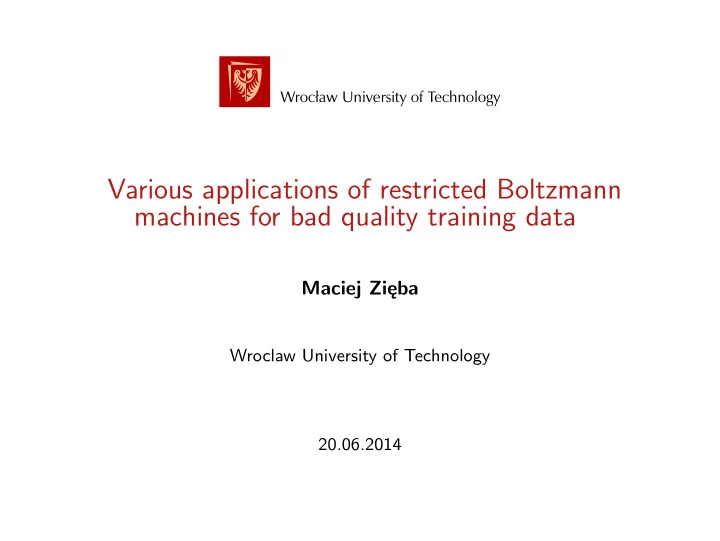

Wrocław University of Technology Various applications of restricted Boltzmann machines for bad quality training data Maciej Zięba Wroclaw University of Technology 20.06.2014
Motivation Big data - 7 dimensions 1 � Volume : size of data. � Velocity : speed, displacement of data. � Variety : diversity of data. � Viscosity : measures the resistance to flow in the volume of data. � Virality : measures how fast data is distributed unique and shared between nodes in a network (e.g. the Internet). � Veracity : trust and quality of the data. � Value : what is the added value that Big Data should bring? 1 According to ATOS company 2/7
Motivation Big data - 7 dimensions 1 � Volume : size of data. � Velocity : speed, displacement of data. � Variety : diversity of data. � Viscosity : measures the resistance to flow in the volume of data. � Virality : measures how fast data is distributed unique and shared between nodes in a network (e.g. the Internet). � Veracity : trust and quality of the data. � Value : what is the added value that Big Data should bring? 1 According to ATOS company 2/7
Veracity of Data Typical problems with data - training context � Imbalanced data problem . One class dominates another in the training data. � Noisy labels problem . Some of the examples in training data contain incorrectly assigned labels. Example of � Missing values issue . Values of some imbalanced data features are unknown. � Unstructured data . The data is represented in unprocessed form: images, videos, documents, XML structures. � Semi-supervised data . Some portion of training data is unlabelled. 3/7
Veracity of Data Typical problems with data - training context � Imbalanced data problem . One class dominates another in the training data. � Noisy labels problem . Some of the examples in training data contain incorrectly assigned labels. Example of � Missing values issue . Values of some imbalanced data features are unknown. � Unstructured data . The data is represented in unprocessed form: images, videos, documents, XML structures. � Semi-supervised data . Some portion of training data is unlabelled. 3/7
4/7 � The joint distribution of visible and hidden units � RBM is a bipartie Markov Random Field with � For binary visible x ∈ { 0 , 1 } D and hidden units � Because of no visible to visible , or hidden to � ( W · j ) ⊤ x + c j h ∈ { 0 , 1 } M th energy function is as follows: E ( x , h | θ ) = − x ⊤ Wh − b ⊤ x − c ⊤ h , � � W i · h + b i − E ( x , h | θ ) � � p ( x i = 1 | h , W , b ) = sigm p ( h j = 1 | x , W , c ) = sigm hidden connection we have: � Restricted Boltzmann Machines (RBM) Z exp visible and hidden units. is the Gibbs distribution: p ( x , h | θ ) = 1 Methods
Methods RBM for imbalanced data � Train the model on examples from minority class by application of MLL (scaled): N 1 = 1 � � � p ( X N � � � N log n =1 | θ ) log p ( x n , h | θ ) N n =1 h � Generate artificial examples ¯ X M m =1 using Synthetic Oversampling TEchnique ( SMOTE ). � For each of the newly created example x m apply Gibbs sampling: h m ∼ p ( h | ¯ x m , θ ) ˜ x m ∼ p ( x | h m , θ ) � Label newly created example ˜ x m and store in training data. 5/7
Methods RBM for imbalanced data - example SMOTE procedure: A B 6/7
Methods RBM for imbalanced data - example SMOTE procedure: A Generating artificial examples on MNIST data: EXAMPLE 1 EXAMPLE 2 B SMOTE SMOTE RBM 6/7
RBM for other raw data issues � Problem of missing values . � RBM is trained for each of the classes separately. � Gibbs sampling is applied to uncover unknown values. � RBM models are iteratively updated while new training example is completed . � Problem of noisy labels . � RBM is trained for each of the classes separately. � Each of the trained models is used as an oracle to detect uncorrected labelled data . � Reconstruction error is used to determine unlabelled examples . � Problem of unstructured data . � RBM is used as domain-independent feature extractor that transforms raw data into hidden units . 7/7
Recommend
More recommend